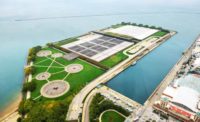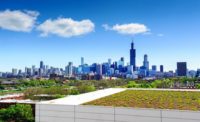The Wharf brings to the nation’s capitol a mixed-use development including retail shops, office space, hotels, residences and a 140,000-square-foot concert hall. Spanning nearly one mile of what was once a stretch of dilapidated and unused space, The Wharf resulted from a coalition of private and public partnerships and helped to transform the District’s smallest quadrant into a vibrant neighborhood where people live, work and enjoy waterfront activities.
Providing experiences along the shore of the Potomac, The Wharf offers 14 acres of parks and public space along with water activities including kayaking, paddle boarding and water taxis. A network of vegetative roof assemblies provides yet another level from which to take in breathtaking views of the Potomac and several national landmarks while gathering or enjoying a cocktail.
The vegetative roofs throughout The Wharf also support sustainability efforts. Efforts to support sustainability began at the master planning stage. The Wharf was designed to achieve LEED ND Gold while targeting LEED Gold or Silver for several individual buildings.
Developed in phases, Phase One of The Wharf took nearly 15 years to complete, opening on October 12, 2017. The building has endured the Great Recession and other challenges along the way, but the final phase is scheduled for completion in 2022. Eventually, The Wharf will include 1,375 residences, 945,000 square-feet of office space and 800 rooms in four hotels. Beyond its size and scale, The Wharf represents an aggressive effort to reinvent the once neglected Southwest quadrant’s waterfront as a destination public space.
At first glance, The Wharf does not appear to be a “planned community” but a “riverfront neighborhood.” Glass and steel are adjacent to cobblestones and rooflines rise and fall. Narrow streets and alleyways contribute a sense of old world charm but presented challenges for teams completing Phase One against an aggressive schedule. Nine different architects designed the first nine buildings, which may help contribute to the sense of diversity. A unifying element in The Wharf is the Promenade, a central walkway tying the community together.
District Codes Call for Vegetative Roofs
The District of Columbia Department of Energy notes there are currently more than 3 million square-feet of vegetative roof in the District. Notable roofs featuring vegetative roof assemblies include MGM Casino, the National Museum of African American History and Culture, National Museum of American Indians, and the National Archives. One of the largest vegetative roofs in the nation, spanning approximately 500,000 square-feet, sits atop the Douglas A. Munro U.S. Coast Guard Headquarters. The assembly used on the Coast Guard headquarters helped inform the assembly of several vegetative roofs throughout the D.C. area and in The Wharf.
Commercial buildings in the nation’s capitol use an innovative cistern system, permeable pavements, and vegetative bio-retention delivered by a network of vegetative roofs. According to Jeffrey Seltzer, PE, Acting Director of Natural Resources Administration, Department of Energy & Environment, regulated development projects in the District are required to install practices that retain runoff from a 1.2-inch storm event typically through green infrastructure and capture/reuse systems employing cisterns.
Protected roof membrane assembly (PRMA) systems for vegetative roofs play an important role in helping AEC professionals comply with the District’s requirements to manage rainwater runoff. The District has mandated green roofs and specified rainwater retention rates relative to a building’s footprint. The District specifies the ratio of pervious versus impervious surfaces, which can sometimes be a challenge for buildings trying to achieve mandated areas of greenspace while also achieving adequate space for vegetation, sidewalks and surfaces.
Managing Stormwater with XPS
Roofing contractor James Myers Co. worked with Preservation & Protection Systems (PPSI) Maryland and Owens Corning to design and install PRMA roof assemblies on several buildings in The Wharf. PPSI and Owens Corning developed the PRMA assembly for the U.S. Coast Guard headquarters and were pleased with its performance and track record of no leaks since its 2018 installation.
More than half of the PRMA roofs in The Wharf use extruded polystyrene insulation (XPS). XPS was selected based on its compressive strength and ability to support many different overburden materials including plants, pavers, pedestals and basins holding the soil in place. XPS was also used in building enclosure areas to deliver energy performance via its high R-value. The basins under the roof pavers contain soil at depths of up to four feet deep and require a high PSI insulation. XPS insulation also hallows water to flow through joints and between specially cut edges to prevent water from ponding.
While rooftop plants and vegetation soak up the rainwater, the insulation helps to control the flow of water from the plant layer, growing media and filter/drainage layer to the waterproofing layer and horizontally to a series of overflow vaults. The Wharf makes use of massive 700,000-gallon cisterns that collect and control the release of water.
Rock curbs from Hanover Architectural Products help mitigate against winds coming in off the riverfront. Other materials used in the PRMA assembly included waterproofing membrane 790-11 Hot Rubberized Asphalt by the Henry Company. EMSEAL expansion joints tied together air barriers in the roofing system and Hanover Architectural Products provided the pavers and sedum mats were supplied by Sempergreen.
A Tight Deadline Demands Organization and Communication Across Teams
The grand opening of The Wharf included a number of special events. Hometown rock band the Foo Fighters presented a grand opening concert at the Anthem music center to celebrate the opening. The sell-out crowd on October 12, 2017, quickly filled the Anthem to its 6,000-occupant capacity. While the days until the grand opening ticked down, a sweltering summer brought temperatures in the mid 90’s and construction teams worked around the clock to complete Phase 1.
The scope and scale of completing multiple buildings against a very tight timeline was a challenge felt by all of the contractor trades on site, according to Brian Davis, General Superintendent at James Myers. The immensity of the project required careful scheduling and logistics among multiple trades. Teams worked throughout the night and seven days a week as Phase One approached completion.
During the final three months of construction, weekly coordination meetings evolved into daily Trades received precise schedules for exactly what team members would be working in what area at a particular time. Davis says the challenge of building nine buildings over six blocks made traffic bottlenecks an ongoing challenge throughout the project. Scheduling details were adjusted to accommodate not only to the District’s notorious rush hour traffic but also traffic to area attractions and events in the District. Even baseball schedules had to be considered. For example, the Washington Nationals baseball schedule featured a number of weeknight baseball games at home. Trades working on The Wharf were required to clear the streets three hours before the first pitch of each home game. Amid all of the hectic scheduling, contractors also had to ensure safety and quality were not compromised.
The opening of Phase One brought together the District and the community at large to create a one-of-a-kind public space that has reenergized one of America’s most historic riverfronts. The installation of green spaces atop the buildings has provided a new vantage point from which to take in one of America’s most historic and beloved waterways, while helping the District achieve sustainability and rainwater management objectives.






